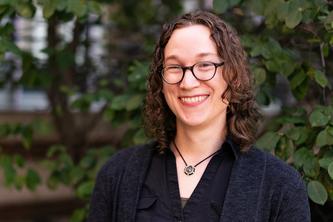Talking about his field, Marcus Flowers leaves no doubt which aspects of it he loves: all of them.
“What’s fascinating about biomedical engineering is, you can tackle a ton of problems from a ton of angles,” says Flowers, a Ph.D. student in the College of Science and Engineering (CSE). “You can work on restoring someone’s eyesight, helping someone regain mobility in their legs, or even simply helping them go through a surgery with less pain.
“It really feels like the sky is the limit. There’s never a shortage of problems we’re interested in trying to solve, and that's really what makes the research exciting.”
Flowers works with CSE Professors Chun Wang, whose lab develops polymer-based healthcare technologies, and Brenda Ogle, whose team focuses on regenerative stem cell therapies.
“My research is focused on drug delivery,” Flowers explains. “[Our research] will make simple, accessible therapies for very common problems. My primary focus is regenerative medicine in cardiac tissue.”
A major project involves 3D printing human heart models to test the delivery of drugs in order to improve treatments for cardiac conditions and, perhaps eventually, cancer.
“Say you have a heart attack, you have a hole in your heart,” Flowers says. “We want to create a patch made from your own cells, put it in there, and fix it up.”
His work is part of CAPRO, an umbrella project out of Wang’s lab to develop materials for delivering therapies to precise targets in the body. Flowers envisions a future patient taking a drug, confident it will only become active “where we want it to.”
Such technology may someday minimize drug side effects and create a system for delivering multiple types of medicine. Wang’s lab currently works with the Mayo Clinic on harnessing the technology to stabilize vaccines in storage.
Back to his future
There’s good reason Flowers has—no pun intended—blossomed at the U of M.
“Growing up around the University of Minnesota, I didn't appreciate how much of a standout institution it was,” he says. “It wasn't until I left and saw other schools that I realized that the U is actually really good at developing people to work on these technologies and creating a good environment for fostering new ideas. I realized that I could do this really cool stuff, and I don't have to go halfway across the country to be involved in it.
“The University of Minnesota has given me a breadth of experience in mentoring and training people, teaching students, [and] working with faculty and people that are involved in even just local government. And all of that is something I plan to carry forward with me.”
- Categories:
- Science and Technology
- Bioengineering
- Research
- Science





